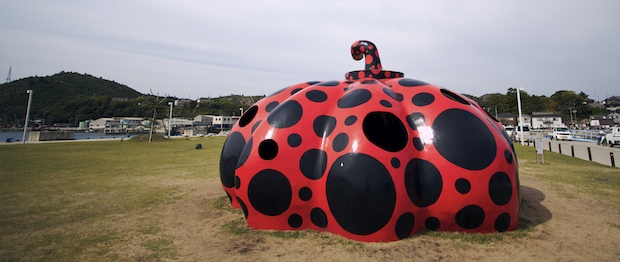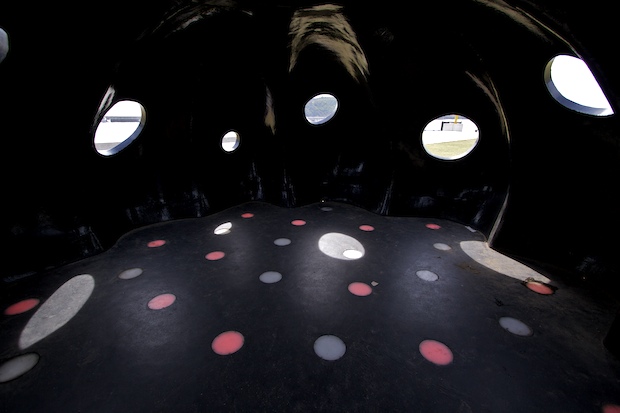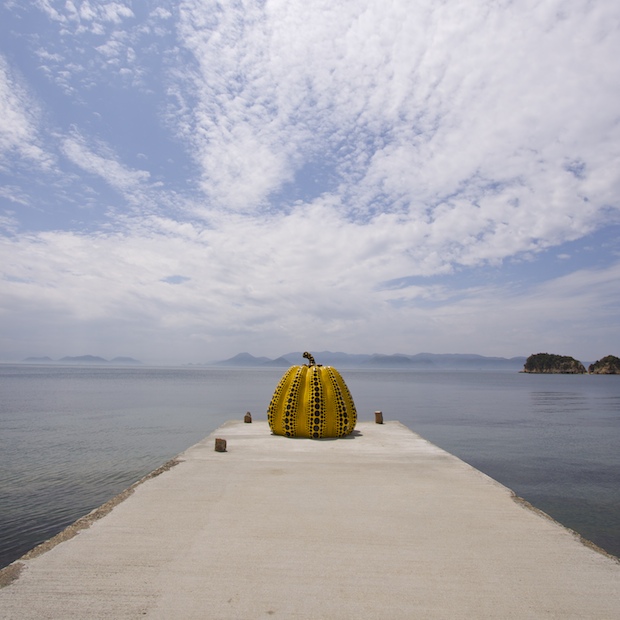Red Pumpkin – Yayoi Kusama, all photos: Owen SchaeferThe first thing you will likely see, as the ferry for Naoshima pulls up to its moorings, is a sculpture of an enormous red-and-black polka-dotted pumpkin. Those familliar with this island just off Shikoku, filled with public and private artworks, will likely recognize the image: it is Yayoi Kusama’s Red Pumpkin, with its counterpoint, Yellow Pumpkin, located on the opposite side of the island in the extensive grounds of the Benesse House museum and hotel (an odd combination of businesses with odd results, but that’s for another post.)
My wife and I spent a (somewhat unprecidented) four days exploring the tiny island, and while I could fill a book with observations and ideas that I scribbled down while there, I’ll try to stick to narrow them down over the next couple of entries.
Unlike most, who scrambled directly over to Kusama’s red work, we saved that particular pilgrimage for our third day. And even after experiencing the strange spectrum of the island’s many rules and regulations regarding its artworks, we were still a little surprised to find a sign next to the pumpkin stating in no uncertain terms that if we were to break the artwork we would be asked to pay for it.
Yes. Naoshima has a you-break-it-you-bought-it policy.
I assume, of course, that this means you would be asked to pay for repairs rather than the entire artwork itself. Much as I’d enjoy my very own (damaged) Kusama, I’m not sure it would fit in my living room.
It should be said here, however, that Kusama’s work has forged in a robust fibreglass, with holes cut so that viewers can enter and peep in and out of its many polka-dot windows — it would take a considerable, and likely deliberate, effort to break it. But more importantly, it is a work that invites participation and, one might even argue, play. Putting a threatening sign next to Kusama’s pumpkin is somewhat akin to placing one next to the playground equipment or even a building. No one is going to care if you lean against the wall of the convenience store, and you wouldn’t be surprised to be asked to pay for damages if you were to accidentally put your foot through its window.
But the sign highlights a certain attitude toward works of “public” art such as this. When placed within reach, they invite curiosity, touch and even playful mockery. But at the same time, by occupying that zone called Art, they call up the spectre of gallery ettiquette — our hands respectfully folded away from the temptation of touch. And it most often seems that investors and collectors would rather we kept our curious digits to ourselves. In fact at times, it is almost as though by touching an artwork — one that has been designed to be touched, that is — it cannot be taken as seriously as before. In our world, the sense of touch is still seen as a base one, unlike the pristine and non-physical appreciation of sight.
When art places itself deliberately outside of the gallery — and I am not talking about corporate art, which is as untouchable in its business settings as in any museum — when it shuns the protection of security guards, glass display cases and strategically placed rope boundaries, it truly enters the public realm. And that is a curiously problematic thing for the nervous owner.
Much of Naoshima’s artworks exist in this kind of uneasy relationship between the visiting public, the local community and the people running the show, and it’s something I’m hoping to explore a little further next week.
Until then, pumpkin pie in the sky:
-Owen Schaefer











